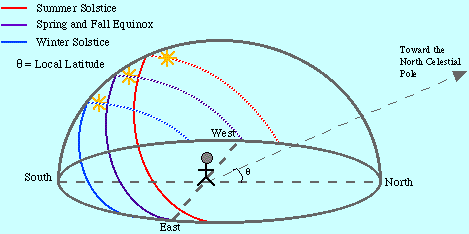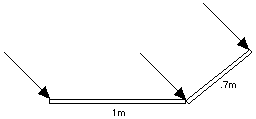(4) The Angle of the Sun's Rays
In the US and in other mid-latitude countries north of the equator (e.g those of Europe), the sun's daily trip (as it appears to us) is an arc across the southern sky. (Of course, it's really the Earth that does the moving.) The sun's greatest height above the horizon occurs at noon, and how high the sun then gets depends on the season of the year--it is highest in mid-summer, lowest in mid-winter. Boy scouts used to be taught (perhaps still are) that someone lost in the woods can often tell the north direction by checking on which side of tree-trunks moss grew best. Moss avoids direct sunlight, and with the sun's path curving across the southern sky, the north side of a tree-trunk is the one most shaded.
The same also holds for the Earth. The rays of the summer sun, high in the sky, arrive at a steep angle and heat the land much more than those of the winter sun, which hit at a shallow angle. Although the length of the day is an important factor in explaining why summers are hot and winter cold, the angle of sunlight is probably more important. In the arctic summer, even though the sun shines 24 hours a day, it produces only moderate warmth, because it skims around the horizon and its light arrives at a low angle. The apparent motion of the sun can be important in designing a building, in particular in the placing of windows, which trap the sun's heat. In a hot sunny climate such as that of Texas or Arizona, it is best to have the largest windows face north, avoiding the sun. The south-facing walls, on the other hand, should be well insultated and their windows should be small, allowing cross-ventilation when needed but not admitting much sunlight (wooden shutters on the outside of the windows also help). In Canada the opposite directions might be chosen, to trap as much heat as possible from the winter sun. Overhangs above south-facing windows also help. In summer, with the noontime Sun high in the sky, such an overhang casts a shadow on the window and keeps the house cool. In the winter, however, when the Sun stays close to the horizon, the overhang allows it to shine through the window and warm the rooms inside. |

 For a similar reason--but to collect sunlight rather than avoid it--solar collectors for heating water or generating electricity always face south. In addition, they are invariably tilted at an angle around 450, to make sure that the arrival of the sun's rays is as close to perpendicular as possible. The collector is then exposed to the highest concentration of sunlight: as the drawing shows, if the sun is 45 degrees above the horizon, a collector 0.7 meters wide perpendicular to its rays intercepts as much sunlight as a 1-meter collector flat on the ground. It therefore heats its water faster and reaches a higher temperature. French wine producers, too, have for centuries preferred southward-facing hillsides, on which ripening grapes get the most sunlight.
For a similar reason--but to collect sunlight rather than avoid it--solar collectors for heating water or generating electricity always face south. In addition, they are invariably tilted at an angle around 450, to make sure that the arrival of the sun's rays is as close to perpendicular as possible. The collector is then exposed to the highest concentration of sunlight: as the drawing shows, if the sun is 45 degrees above the horizon, a collector 0.7 meters wide perpendicular to its rays intercepts as much sunlight as a 1-meter collector flat on the ground. It therefore heats its water faster and reaches a higher temperature. French wine producers, too, have for centuries preferred southward-facing hillsides, on which ripening grapes get the most sunlight.

 Author and curator: David P. Stern,
Author and curator: David P. Stern,